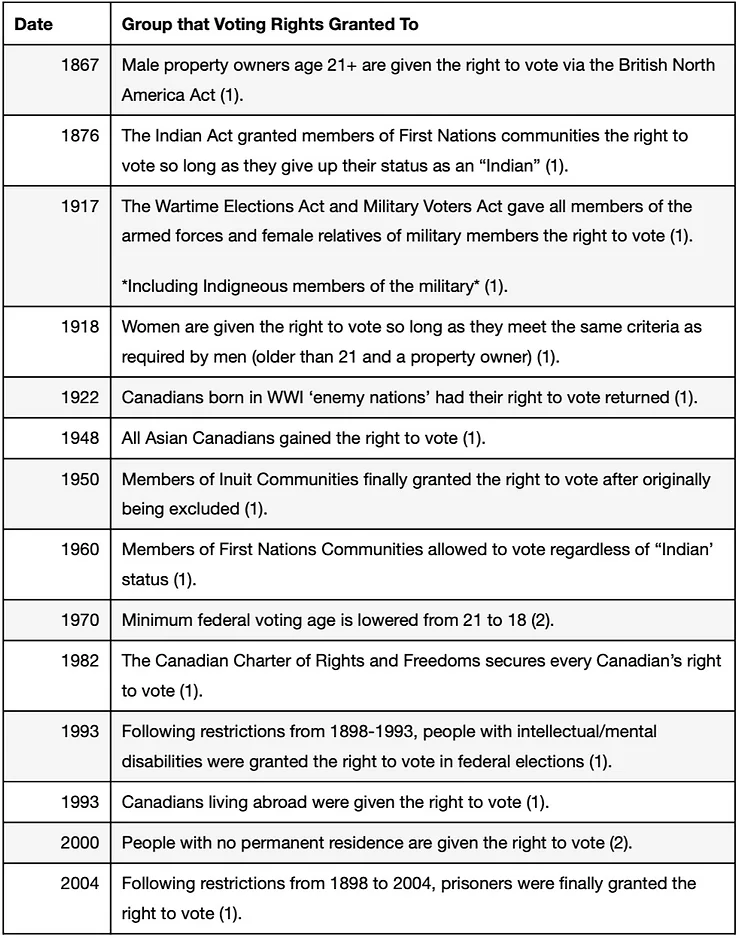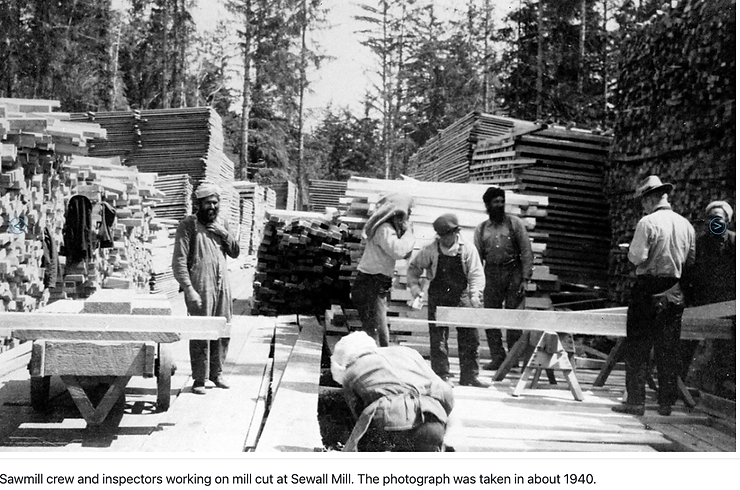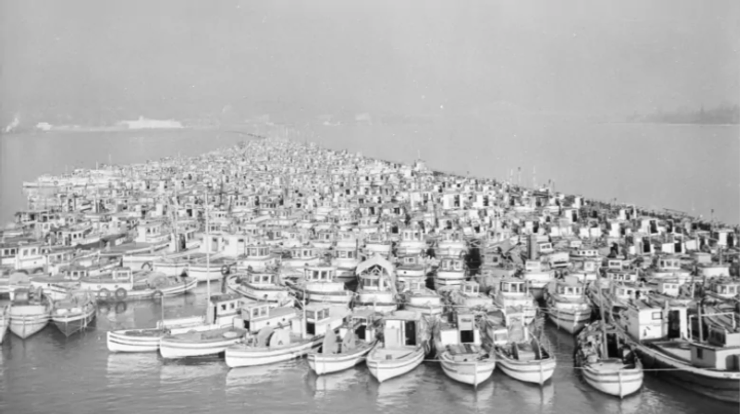Voter Rights Timeline: Systemic Barriers Towards Voting Experienced by Historically Excluded Groups
Author
Meagan Parmassar
Hello! My name is Meagan (she/her) living on the traditional territory of the Anishinabewaki peoples. I acknowledge that this land is covered by Treaty 19, also known as the Ajetance Purchase (named for the Chief of the Mississaugas of the Credit), signed in 1818. I would like to acknowledge my positionality as a cis-gendered, Indo-Caribbean immigrant woman. My intention is not to speak on behalf of communities of which I am not a part of, particularly Black and Indigenous communities, rather to bring awareness to environmental injustices and other social disparities that disproportionately affect marginalized communities through my writing. My goal is to use this opportunity to help these communities and the cause in the best way that I know how, which is through education, raising awareness and challenging the system of ideas and beliefs that led to these problems in hopes of influencing a political and social shift. As a second generation immigrant, I realize that my views and interpretations of certain topics may be different than those of members of the Indigenous or Black communities. Today, I will be sharing my research and interpretations of white supremacy in Canadian politics, while understanding and recognizing the difference my positionality may make in my understanding of it.
Editor
Aarisha Elvi Haider
Timeline Creator
Anna Huschka

It is irresponsible to deny the systemic racism ingrained in what is currently Canada, and namely, in our settler/colonizer-based governmental structure. Racialized communities continue to face barriers in participation and representation in the current political system designed by, and for, white individuals.
Historically, non-white communities have had to advocate to be granted the right to vote and to be involved in any capacity in the democratic process within the settler/colonial government. Below is a timeline that provides a brief overview of when different groups in Canada were granted the right to vote in a federal election.

*Members of Métis communities and People of Colour (excluding Asian Canadians) were never officially excluded from voting, and were able to vote so long as they met gender, age and property requirements at the time, but these communities faced other barriers that made voting difficult and inaccessible (1).*
Voting Timeline Resources:
Elections Canada. A Brief History of Federal Voting Rights in Canada [Internet]. What is currently Canada: Elections Canada; [cited 2021, July 19]. Available from: https://electionsanddemocracy.ca/voting-rights-through-time-0/brief-history-federal-voting-rights-canada
Elections Canada. Voting Timeline [Internet}. What is currently Canada: Elections Canada; [cited 2021, July 25]. Available from: https://www.elections.on.ca/content/dam/NGW/sitecontent/2016/education/Voting%20Timeline.pdf
This piece will take a more in-depth look at the barriers faced by the communities mentioned above. Be sure to keep reading to learn more about barriers faced by these communities in their fight to live and vote in what is currently Canada.
Black communities secured freedom and rights during the gradual abolishment of slavery between 1793 and 1834 (1). As they became to be considered British subjects, they were technically allowed the same rights and privileges that the status carried, and that did in theory include the right to vote (1). As such, Black men were able to vote, but only under conditions that recognized them as naturalized subjects who owned taxable property (1). Further, Black women received the right to vote at the same time as white women in Canada, as long as they were eligible to own a taxable property and had their citizenship (1). This is not unique to the Black community, as until 1920, most colonies or provinces required eligible voters to have a taxable net worth or own property (1). This practice, however, functioned to systematically exclude the working class and other historically oppressed communities, namely Black individuals, Indigenous individuals and People of Colour (BIPOC) (1). While their official status in the eyes of the law had changed, the mistreatment of Black communities continued to persist through overt and invisible forms of discrimination. Although they were not prohibited by law to exercise the right to vote, hostile public sentiment against Black Canadians to exercise this autonomy did exist; and this discrimination affected their decisions to visit polling stations, impacting turnout (1). Interestingly enough, former Prime Minister Wilfred Laurier (1896-1911) signed an order-in-council to ban Black immigration in Canada. Although the order never became a law, it clearly exhibits what researcher R. Bruce Shephard calls Canada’s “campaign of diplomatic racism” (2, 3).
In B.C., Indo Canadians were denied the right to vote until 1947 (3). The first immigrants of Indian descent arrived in Vancouver in 1903, and up until 1907, were relatively unnoticed by the government (8). European settlers grew hostile because employers favoured them working for a lower rate of pay, and the government implemented various racist policies (8). This includes revoking their right to vote and requiring that they come to Canada with $200 cash in their name, while European settlers only needed $20 (8). Therefore, immigration for those of Indian descent was almost impossible. Despite this, they persevered. By 1923, many owned successful businesses and worked extensively in a number of sectors, participated in the armed forces, and contributed significantly to B.C.’s robust forest industry, which collectively aided in building of this nation (8, 9). Yet without the right to vote, they were still seen as second-class citizens, regardless of the fact that they were British subjects and held British passports (as Britain had colonized India at the time, and India only gained independence in 1947) (8).

Caption: Sawmill crew working on mill cut at Sewall Mill – circa 1940 (13)

The Japanese arrived in Vancouver in the late 1800s in tens of thousands, and did not get their right to vote until 1949 even though they had fought for Canada in the First World War (1914-1918) (3). They contributed greatly to the fishing industry in B.C. but in spite of this, there was social unrest and opposition to Japanese immigration by European settlers, and so their immigration was restricted by the B.C. government (10). After that, Japanese immigration dwindled substantially, and continued to make up a small percentage of Canadian immigration (10). Further, European settlers also grew uncomfortable with their large representation and success in the fishing industry, and so the amount of licenses issued to Japanese immigrants were also limited by the Federal government (10). After Pearl Harbour was bombed in 1941, the government began impounding boats and revoking the licenses of Japanese fishermen, devastating the community and the industry, despite many of those workers having been in the country for decades (11).
Chinese Canadians first arrived in B.C. during the gold rush of 1858. They helped with mining gold, and later helped to build the Canadian Pacific Railway (12) but were not granted the right to vote until 1947 (3). By 1900, canned salmon was one of B.C.’s most valuable exports, and the industry was largely built with the help of Chinese Canadian labourers (12). Despite their contribution to the building of the nation, in 1885 the Chinese Immigration Act required that Chinese looking to immigrate to Canada must pay a $50 head tax per person, which was raised to $500 in 1903 (13). This is more than a year’s wage for a labour worker at the time. Another Chinese Immigration Act was passed in 1923, greatly restricting Chinese immigration once again (12). Most of these laws were enacted due to public anti-Chinese attitudes, particularly when the economy would downturn which highlights how heavily white supremacy influenced political decisions (12, 13).

Caption: Fisherman’s Reserve gathering and impounding Japanese fishing boats. December 10, 1941 (15).
Policies that are inherently racist continued to be passed in recent years. In 2014, Stephen Harper passed Bill C-24: Strengthening Canadian Citizens Act (14). This act essentially created second-class citizenship, in which one was subject to be stripped of their Canadian citizenship if they were landed immigrants, held dual citizenship, or were eligible for citizenship in another country (14). This has been criticized as part of an underlying agenda to portray immigrants as untrustworthy and suspicious, treating dual and naturalized citizens (often visible minorities) as less than single-nationality citizens (majority White) before the law (15), which highlights white supremacy and white nationalism on a systemic level. Further, the Zero Tolerance for Barbaric Cultural Practices Act, passed in June 2015 by the Harper government, is also inherently racist. The goal was to abolish polygamy, child marriages and ‘honour killings’ among minority communities in Canada (14). However, polygamy has been illegal in Canada for over a century; and in terms of child marriage, this law only restricted marriage for those 16 and under while according to the United Nations, child marriage applies to anyone under the age of 18 (14, 15). Therefore, this act does not adequately address the issue of child marriage at large (17). The use of the word ‘barbaric’ in relation to ‘culture’ in the title of this bill is both inflammatory and insulting towards certain cultural groups, and was predominantly directed towards Muslims. (14, 18).
Systemic racism in Canada goes beyond just policy – racist individuals continue to persist in Canadian political parties as well. Leading up to the 2019 Federal election, B.C. candidate Brian Misera for the PPC (Coquitlam-Port Coquitlam) asked leader Maxime Bernier to denounce racism and white supremacy, and to dissociate from far-right white supremist organizations showing support for him and his party (19). Shortly after this, he was taken out of the running for the party, and Bernier has yet to condemn white supremacy (19). In 2019, the Canadian Nationalist Party registered itself with Elections Canada, with one of their priorities stated to maintain, “the demographic status of the current European-descended majority” (20).
For resources on how to be anti-racist, and to continue learning about how to be a better ally, check out our free resource compilations on the Active Learning Club (ALC) page.
References
- https://www.thecanadianencyclopedia.ca/en/article/black-voting-rights (1)
- https://thetyee.ca/News/2019/07/08/Racism-Canadian-Politics/ (2)
- https://humanrights.ca/story/the-chaotic-story-of-the-right-to-vote-in-canada (3)
- https://indigenousfoundations.arts.ubc.ca/the_indian_act/#origins (4)
- https://www.facinghistory.org/stolen-lives-indigenous-peoples-canada-and-indian-residential-schools/historical-background/dispossession-destruction-and-reserves (5)
- https://www.facinghistory.org/stolen-lives-indigenous-peoples-canada-and-indian-residential-schools/historical-background/defining-indian (6)
- https://opentextbc.ca/indigenizationfoundations/chapter/the-indian-act/ (7)
- https://www.ufv.ca/media/assets/sasi/BCHF-Story-on-the-Vote-(final).pdf (8)
- https://learning.royalbcmuseum.bc.ca/pathways/punjabi-experience-british-columbia/look/ (9)
- https://cha-shc.ca/_uploads/5c365d73ec34b.pdf (10)
- https://www.cbc.ca/news/canada/british-columbia/lost-fleet-exhibit-shows-how-racist-policies-devastated-b-c-s-japanese-fishing-community-1.4041358 (11)
- https://www.bac-lac.gc.ca/eng/discover/immigration/history-ethnic-cultural/early-chinese-canadians/Pages/history.aspx (12)
- https://www.rcinet.ca/patrimoine-asiatique-en/le-mois-du-patrimoine-asiatique-au-canada/limmigration-chinoise-au-canada/ (13)
- https://ccla.org/canada-legacy-racist-policies-confront/ (14)
- https://www.broadbentinstitute.ca/pattitamaralenard/conservative_law_creates_second_class_citizens (15)
- https://toronto.citynews.ca/2018/06/26/a-timeline-of-polygamy-in-canada/#:~:text=Canada%20passes%20legislation%20outlawing%20polygamy,for%20refusing%20to%20renounce%20polygamy. (16)
- https://www.ctvnews.ca/canada/child-marriage-in-canada-means-country-s-efforts-to-end-it-abroad-are-insincere-researcher-1.4467778 (17)
- https://theontarion.com/2014/12/04/canadas-zero-tolerance-for-barbaric-cultural-practices-act/ (18)
- https://globalnews.ca/news/5897441/bc-ppc-candidate-expelled/ (19)
- https://globalnews.ca/news/5985342/canada-election-white-supremacy/ (20)
- https://ottawacitizen.com/news/local-news/we-still-have-a-long-way-to-go-throne-speech-commits-to-plan-for-increasing-bipoc-representation-in-public-service-hiring-appointments (21)



